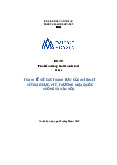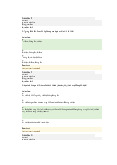



















Preview text:
58 PARTT\NO SHIP TYPES, SHIPPING ORGANISATIONS AND DOCUMENTATION
4 Ships and Specifications
It is estimated that almost 90% of all global trade today is transported by sea.
It is therefore fundamentally important that a logistics service provider must
have a complete knowledge and understanding of the various types of vessels
available in the freight market, the different functions of each type of vessel,
and how they are operated. Registration of a ship
Just as cars need to be registered before they are allowed on the road, so too do ships
need to be officially registered. Each vessel is given a unique code, which is used for
radio communications and as identification on all documentation. Ships do not have
to be registered in the country that they are built or based in, so owners are likely to
register their vessels in those countries that offer the best financial benefits - lower tax
rates or tax-free status - which add up to substantial cost reductions.
A complete list of calling codes of every vessel around the world is kept on a central
record at Lloyd's Register of Shipping in London, along with records of their movements and last reported position.
One of the most important documents on board any vessel is the logbook. Officers must
keep a daily record of each and every event that takes place on board the ship. Typical
entries would include the ship's current position, the ship's course, all ports of call,
weather conditions, and any other special e
vents, such as the handling of claims.
PART 2 Iii Ships and Specifications 5 9
Classification of ships
Every four years (although one year's grace is normally given), the class certificate for
a particular ship expires. It is immobilised for several days, while a series of extensive
checks are conducted by a classification society to ensure that the vessel is in satisfactory
condition to be carrying its cargo and crew. If the ship meets the requirements, it is re
classified according to the standard of its construction and on-board equipment.
T his process not only deems a ship seaworthy, but also determines the cost of insurance
for both the ship and the cargo it carries - a ship with a higher classification fetches a
lower insurance premium than one with a lower classification; it is therefore advantageous
for owners to maintain their ships to the highest standard.
Apart from these surveys to maintain classification, ships also undergo annual checks,
to make sure that the general condition of the ship, including its anchors and cables, is
satisfactory. A load-line survey is also done at the same time.
Some major international classification societies are: Company/Nationality Symbol
Lloyd's Register of Shipping, London/UK LR
American Bureau of Shipping, New York/USA AB Bureau Veritas, Paris/France BV
Germanischer Lloyd, Berlin/Germany GL Det Norske Veritas/Norway NV Nippon Kaiji Kyokai/Japan NK Registro Italian Navale/ltaly RL The Plimsoll Mark
In 1836, public concern grew over the number of ships and crew lost at sea. The British
Parliament appointed a committee to investigate, and legislation was passed in 1850 to
create the Marine Department of t
he Board of Trade. Its role was to enforce the application
of laws governing manning, crew competence, and operation of merchant vessels. In 1870,
Samuel Plimsoll, a merchant and shipping reformer, created a safety limit: a "load-line".
In the Merchant Shipping Act of 1875, this line (known as the Plimsoll Mark) became
an internationally accepted reference to limit the weight of cargo loaded aboard ships.
How low a boat is able to safely sit in the water can be measured by its draught, which
is the vertical distance from the bottom of the keel to the waterline. 6 O
Guides to International Logistics l !l Seafreight Forwarding
Some factors for determining the Plimsoll Mark include: structural strength; • compartmentalisation; • deck height; • transverse stability; • hull form; • length of the ship; • type of vessel; • cargo on board; and • season and zone.
In addition to having this line permanently marked on both sides of the hull, each
vessel must carry a load line certificate, issued by a classification society, stipulating the
distances and draughts required for that particular vessel. ---- --- Waterline -, ----IIL-- ..., ·
Laying empty with little or no ballast _e_�y _ ___ �1----""-'-line �,,,.,,,....IM
Loaded to legal limits for sea conditions expected in the
North Atlantic in winter - plenty of reserved buoyancy Loaded deep for tropical seas
PART 2 Ill Ships and Specifications 6 1
The profile of a ship and commonly used terms Length Overall (LOA)
The greatest length of the ship, from fore to aft. This length is important when docking the vessel. Beam
The greatest breadth of the ship, from port to starboard. Draught
The distance from the bottom of the keel to the waterline. Freeboard
The distance from the waterline to the top of the deck plating at the side of the deck amidships. Displacement
The weight of the ship and all that it contains - cargo, fuel, water, stores, crew and
effects. A ship can have different displacements at different draughts. Lightweight
The weight of a ship when empty of stores, fuel, water, crew or their effects. Deadweight (DWTI
The difference between the displacement and the lightweight.
The Gr oss Register Tonne (GRTI
The total cubic measurements of the ship (including engine room, bunker tanks for fuel
and water, seamen's accommodation). The Net Register Tonne (N RTI
The NRT is the available cubic capacity for cargo.
1 register tonne = 100 ft3 (2.8316 m3)
The register tonne is a cubic measure and not a weight indication. Other descriptions of
the ship's cubic capacity are grain (its capacity to hold bulk cargo) and bale (its capacity to hold packed cargo).
Guides to International Logistics m Seafreight Forwarding
------ L-------- enoth overall �fl ------------- ------- ---_ � --- � Centertine bulkhead Profile of a ship Speed and how to calculate it
A ship's speed is measured in knots, which can be expressed in nautical miles per hour.
1 nautical mile = l' (minute) of the earth's surface at the equator = 1,852 m.
Since 1 ° = 60', 1 ° = 60 nautical miles. By formula:
Speed (knots)= Distance (nautical miles)-+- Time (hours)
Therefore, if the distance and time travelled are known, then the ship's speed can be
calculated. Likewise, if the speed and the distance between two ports are known, then
the transit time can be calculated.
PART 2 Iii Ships and Specifications 6 3
The term "knot" originates from the time of the sailing ship, when a rope tied with knots
at regular intervals of 48 feet (8 fathoms) was thrown into the sea behind the ship in
order to find its speed. The number of knots that passed through the hand of the seaman
holding the rope per 28 seconds, as measured by an hourglass, told roughly how fast the ship was going. Types of ships Liner vessel
Liner vessels work to a fixed schedule;
they sail on specific dates between
predetermined groups of ports, irrespective
of whether they have a full load of cargo.
It is imperative that these vessels keep
to their sailing schedule, to maintain the
reputation of the shipping company that
owns them. A majority of container ship
owners today operate liner services on
most of the world trading routes. However,
some conventional or break bulk vessels
also still operate liner services in certain parts of the world where the nature and the
volume of cargo and the port conditions warrant the use of such vessels. Tramp vessel Tramp vessels sail only when
there is a sufficient quantity of cargo on board; they do
not operate on a fixed sailing schedu le. These vessels
generally carry cargo in bulk, such as coal, grain, timber,
sugar, ore, fertiliser, cement clinker, copra, bauxite and phosphates. As many of these types of cargo are seasonal, it would only be viable to transport them a shipload at a time. Many tramp vessel operators work on a much
smaller scale than their liner counterparts, and must therefore have an intimate knowledge
of market conditions and their business demands.
Guides to International Logistics l!il Seafreight Foiwarding 64 11 Container ship
A container ship is especially constructed and fitted to handle and transport containerised
cargo. Most container ships have no loading gear, so the containers are handled and
loaded by large gantry quay cranes while the ships are in the ports.
The conr:ept of using containers in the transport industry was introduced inl 956 by an
American trucker called Malcolm McLean. He initiated "container traffic" as it is known
today, moving cargo between the US coasts via the Panama Canal. In doing so, he began
competing with other truckers and railways. Since its beginning, containerisation has
grown into a massive business and it is today the main mode of sea transport arou_nd
the world. To accommodate the increasing amount of cargo being moved on a daily
PART 2 l!i Ships and Specifications 6!:
basis and the growing demand for shorter delivery times, container ships have grown
to a carrying capacity of 8,000 TE Us. In this industry, it is important to be able to predict
supply and demand; the next generation of 10,000-TEU vessels are already in the order
books of some shipyards and will be in service from 2007.
Conventional or break bulk ship
Break bulk ships are characterised by large open hatches, and are fitted with boom
and-winch gears or deck cranes. Loading and unloading of these ships is done by
either the port's shore cranes or by the ship's derricks - shipside operations are carried
out manually by stevedores. As much manpower is needed to facilitate the running of
break bulk ships, they are now primarily used at ports where labour is cheap. These
ports lack modern facilities or inland rail/highway connections, which are required to
support efficient container ship operations. Although break bulk ships were extensively
used up until the middle of the 1960s, they are no longer commercially viable, and fewer
of these ships are being built each year. RO/RO (Roll On/Roll Off) ship
RO/RO ships are designed to carry automobiles and heavy trucks as their primary cargo.
These vehicles are driven or towed on and off the ship, using either the ship's own ramps
or shore-based ramps: thus the name Roll On/Roll Off.
These ships can also load break bulk goods, heavy cargo and containers, but because
they are not designed specifically to accommodate cargo which can be stacked in a
uniform manner, the space below decks cannot be utilised as efficiently as on a container
ship. This other cargo is loaded onto a low-bed trailer and trucked over a ramp into the ship's hold. LASH ship
The Lighter Aboard Ship (LASH) was introduced in 1969. It is a single-decked vessel
with large hatches, wing tank arrangements, and clear access to the stern.
LASH barges are deployed to smaller
ports to collect and drop off cargo, after
which they are towed to a marshalling
point out at sea, and subsequently loaded
onto the LASH ship. A typical lash barge
has dimensions 18.75m x 9.5m x 3.96m,
cubic capacity of 555m3 and an average deadweight of 385 tonnes. 6 6
Guides to International Logistics II! Seafreight Forwarding
A LASH ship has the capacity for 64-89 barges. They are used to transport large amounts
of inexpensive cargo, and operate in regions with extensive inland waterways and shallow
ports. As on-board cranes are used to hoist the barges off and lower them into the water,
no special docks or terminals are required. Bulk carrier
Bulk carriers are normally tramp vessels which are chartered for a single voyage, or for
transporting seasonal cargo such as grain, ore and coal. These vessels resemble tankers,
but have no loading gears and can vary in size. Some of the biggest bulk carriers are
about 75,000 DWT, or Panamax - the term used to d
escribe the maximum size of a vessel
that can pass through the Panama Canal. Oil tanker
Oil tankers are the largest of all ocean-going transport vessels, with sizes varying from
50,000 DWT to 360,000 DWT. There are two categories of these super tankers: the VLCCs
(Very Large Crude Carriers), with a size of 280,000 DWT, and the ULCCs (Ultra Large
Crude Carriers), with a size of 360,000 DWT and above. 6 7
PART 2 IS! Ships and Specifications
When the Suez Canal was temporarily closed in 1976, these tankers were forced to take
a much longer journey around the Cape of Good Hope, which had a direct bearing on
costs and delivery times. Tanker tonnage therefore had to increase to over 360, 000 DWT.
drawing over 20 metres draught, to meet market demands.
However, the use of the ULCC has diminished due to several factors. Recent oil spills
and the resultant damage to the environment has made them a potential hazard. They
are also extremely costly to maintain, and the discovery of new sources of oil that are
geographically closer to importing countries means that it is no longer necessary or
financially viable to transport oil using such large vessels. LNG/LPG tanker
LNG (Liquefied Natural Gas) and LPG (Liquefied Petroleum Gas) tankers are used solely
for the transportation of liquefied gas and are therefore specially constructed to·carry
them in special pressurised tanks. Most contracts for LNG tankers are taken out on a COA
(Contract of Affreightment) basis, and they are therefore chartered out long-term.




